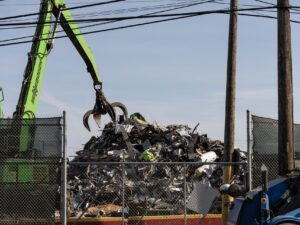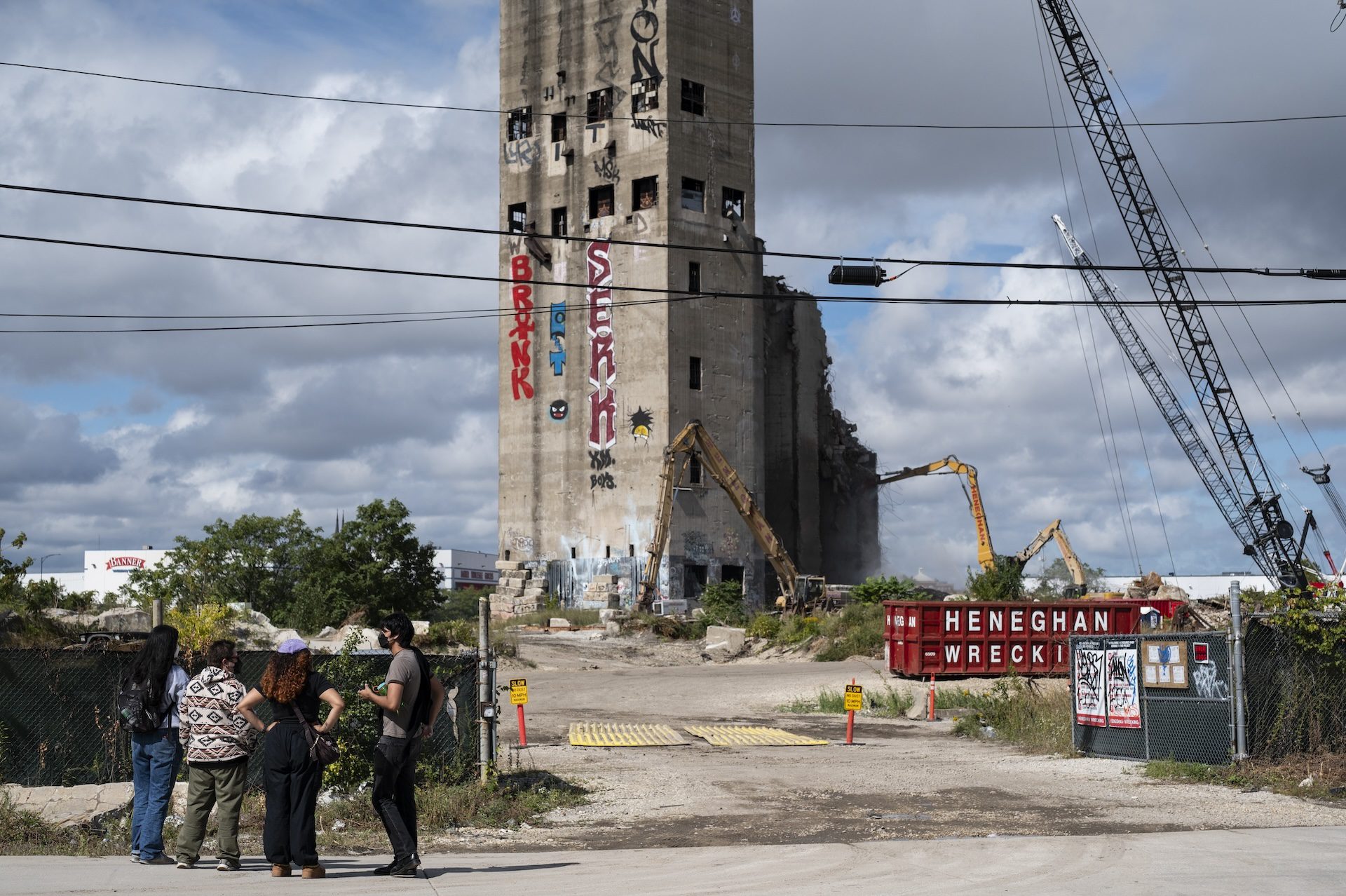 Max Herman/Borderless Magazine
Max Herman/Borderless MagazineFor months, activists have been surveilling the Damen Silos demolition to ensure that environmental protection measures are in place and enforced.
On a Friday afternoon in September, Kate Eakin and a volunteer drone photographer surveilled the Damen Silos demolition site. They captured photos and videos of what appeared to be dust hovering over the concrete towers being torn down, and sent some of them to Ald. Julia Ramirez (12th).
It’s the kind of message Ramirez had been getting from Southwest Side residents monitoring the demolition of the historic silos — a site that’s been a familiar marker of home all her life.
“Some people may feel like it’s call-out culture,” Ramirez said. “I think it’s just these checks and balances.”
News that puts power under the spotlight and communities at the center.
Sign up for our free newsletter and get updates twice a week.
Eakin, executive director of the McKinley Park Development Council (MPDC), recruited volunteers to document the demolition process since it began in July. They’ve been pointing phones and drones at the century-old towers, creating an informal surveillance network of residents monitoring for water and air pollution.
They say they are stepping in to fill gaps in oversight of the complex demolition in a community already burdened by industrial hazards.
Eakin says concerns and skepticism over demolition oversight stem from the city’s history of handling complex demolitions.
The Chicago Department of Public Health (CDPH) issued a temporary stop-work order last week to investigate dust noticed by city inspectors at the site to evaluate whether current dust mitigation plans are sufficient as the demolition focuses on the largest tower remaining. However, the work resumed on Wednesday, according to city officials.
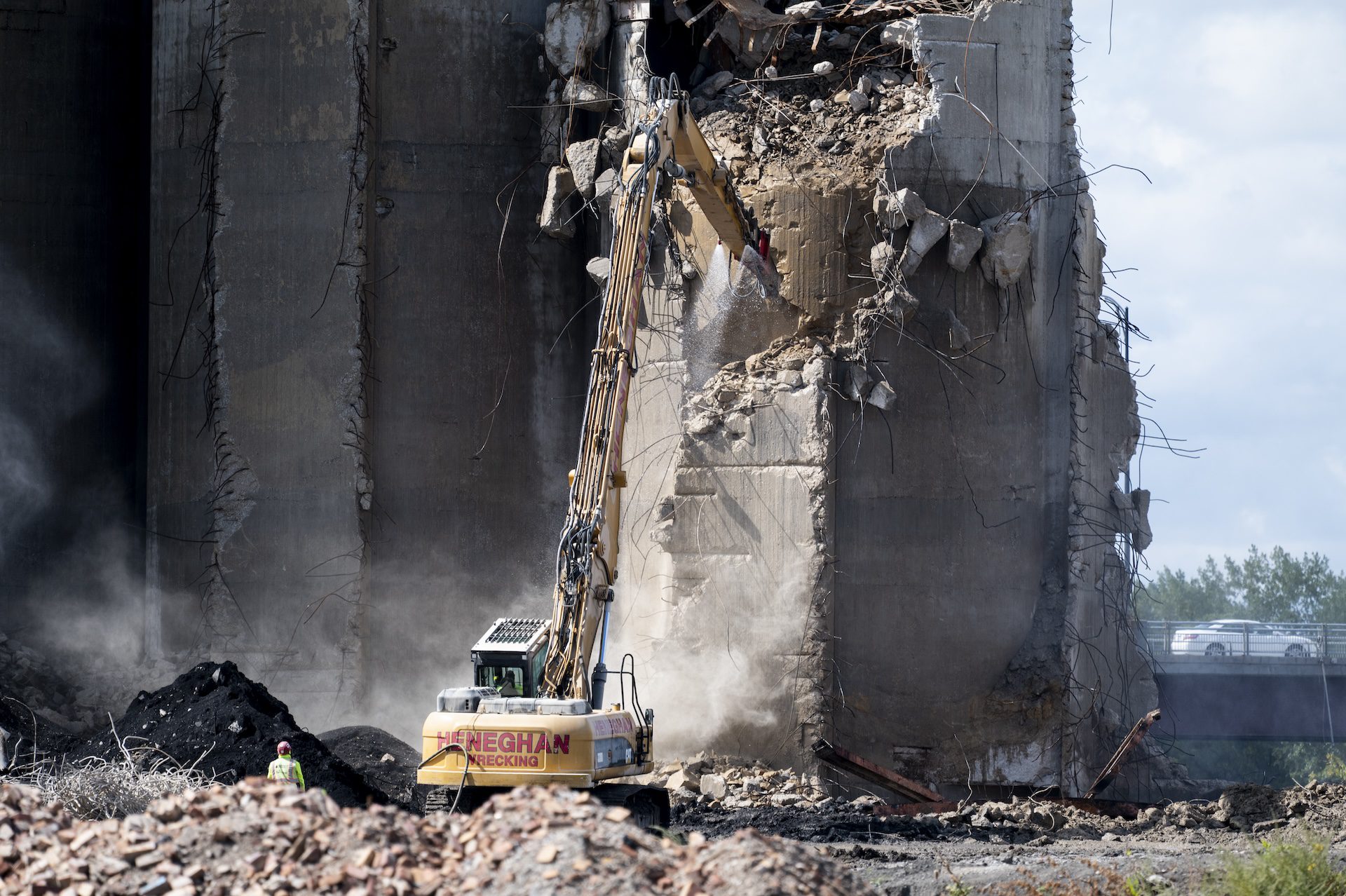
Eakin said she was pleased to hear the demolition paused after noticing issues.
“We hope that changes in the demolition plan will make real improvements to protect neighbors and natural resources,” she said.
Last year, debris from the Bally’s Chicago casino demolition spilled into the North Branch of the Chicago River. In 2020, a smokestack implosion in Little Village sent a dust plume over the neighborhood that residents blamed for health issues.
Three years ago, Michael Tadin — owner of an asphalt plant that has generated hundreds of complaints since 2018 — bought the 23-acre Damen Silos site from the state for $6.5 million.
The purchase left Southwest Side residents bracing for another polluting industry. The neighborhood is already home to a controversial metal scrap shredder, manufacturing plants and high diesel truck traffic.
Leading up to the sale, advocates pushed for the site’s redevelopment into festival grounds, according to reporting from Block Club Chicago.
Tadin told Borderless Magazine that there are no plans for the future use of the site after the demolition is completed. He also contended that city inspectors have been on-site throughout the entire demolition process and that there have been no environmental violations since the demolition began.
Historical significance and ongoing demolition
Built in 1906, the historic Damen Silos became Chicago’s first skyscraper, transforming the city into a regional hub for agricultural exchange. For 70 years, grain flowed through the structures that served as grain elevators.
Even after closing in 1977, the towers remained iconic. They have been a familiar sight to commuters on the Stevenson Expressway and the Orange Line, a backdrop to countless landscape photos of the Chicago skyline, and featured in Michael Bay’s 2014 film “Transformers: Age of Extinction.”
Now, after nearly half a century of standing abandoned over the Chicago River, they’re almost gone.
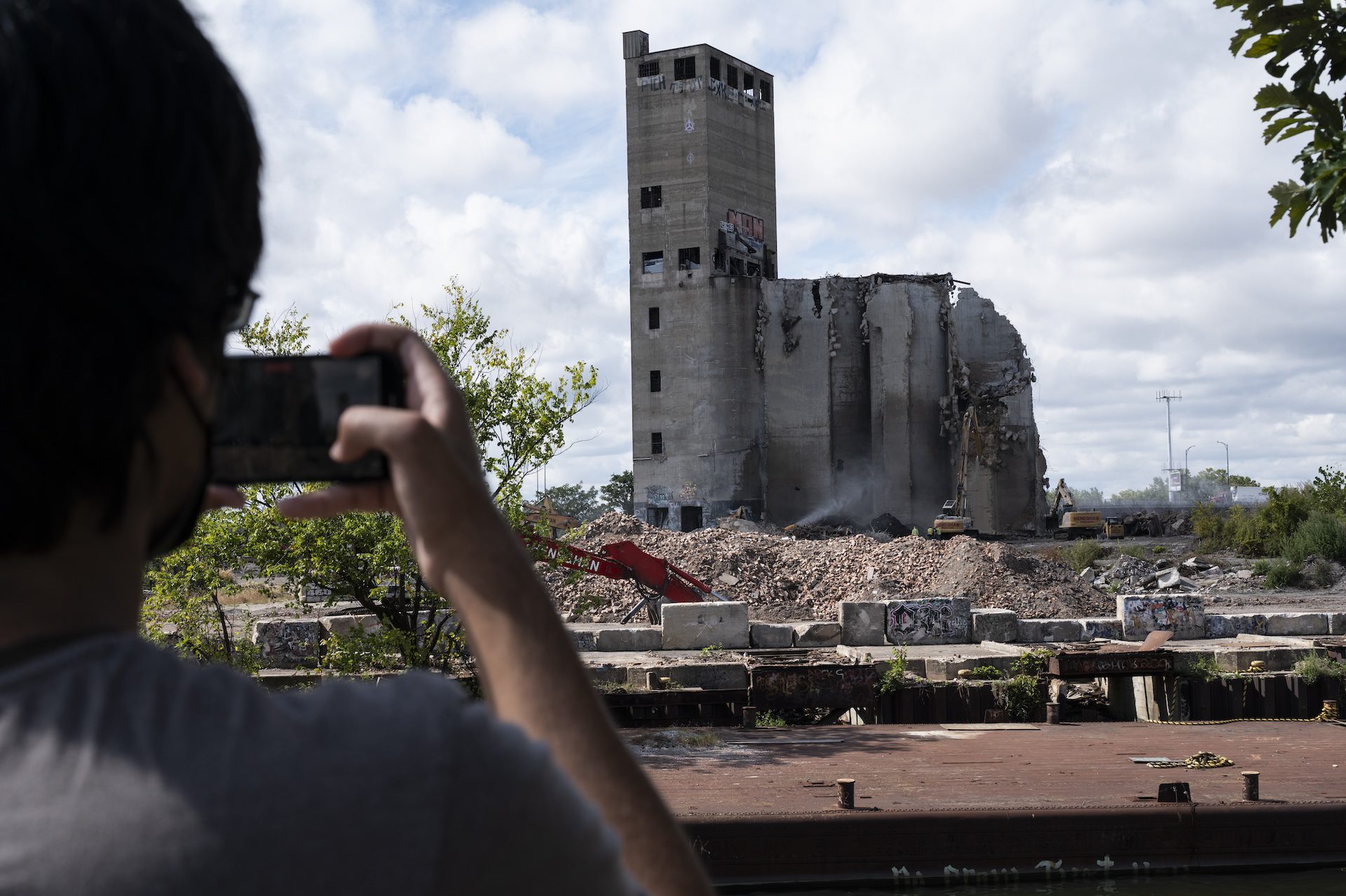
Since the demolition began three months ago, Heneghan Wrecking Company has taken down the buildings surrounding the silos and large parts of the silos, sparking concerns from those surveilling the operation about whether the demolition is happening too quickly to ensure environmental regulation compliance.
The city’s Department of Buildings (DOB) and the CDPH are overseeing the demolition, and inspectors from both agencies are expected to be on site for the entire process.
According to CDPH, they may also issue tickets for air pollution-related issues and material mismanagement. The contractor is required to recycle or reuse at least half of the demolition remnants. The agency can also stop the demolition if inspectors detect dust leaving the site and if air monitoring shows that PM10, fine and coarse particulate matter levels that can trigger respiratory problems, exceed the set limit for two consecutive days.
Alfredo Romo, executive director of Neighbors for Environmental Justice (N4EJ) based in McKinley Park, is concerned about dust from the demolition of the old concrete structures, especially on windy and poor air quality days.
He said CPDH should also monitor the air for finer particulate matter, PM2.5, and wants the air monitoring data to be made available to the public.
Read More of Our Coverage
Air monitors only detected elevated PM10 levels on multiple days during the Canadian wildfires, CDPH said. Still, the agency says it has not observed any violations since the demolition began despite the temporary pause.
“PM10 is monitored because it is the best measure to determine if dust is leaving the site,” CDPH said.
But Pilsen Environmental Rights and Reform Organization (PERRO) members say they have noticed dust plumes coming from the demolition operations even though it was being hosed down.
Ajay Chatha, PERRO organizer who has been monitoring the demolition progress three times per week, said the temporary pause allowed residents to breathe, but was unsure how an updated plan would better protect the community when work resumes.

When asked about community concerns, DOB Commissioner Marlene Hopkins said the agency spent months coordinating with CDPH before issuing demolition permits in July, developing what it called a comprehensive framework based on lessons from past demolitions. The agency said multiple community meetings allowed residents to raise concerns about dust control and other environmental protections, which, she said, lead to a stronger demolition plan.
“We cannot and will not repeat the mistakes of the past, which is why complex demolitions require stringent review and public engagement,” Hopkins said. “This isn’t just about issuing permits in accordance with code — it’s about accountability and going beyond minimum requirements when community safety demands it.”
Some locals have also expressed concern that the demolition is happening too quickly, potentially skipping crucial measures to control dust.
The DOB said that the timeline communicated to the public “has always been dependent on the weather, and as recent weather conditions have been satisfactory, there have been fewer delays in work.”
The agency also said that a series of steps follow the demolition of the building, including clearing the debris, sorting and separating materials, backfilling open foundations and leveling the site.
River Concerns
The U.S. Army Corps of Engineers (USACE) has primary jurisdiction over the river, where barges have been positioned to catch falling debris.
The USACE’s role is to halt or modify work if necessary and ensure permit compliance. It does not regulate general pollutants or chemical contamination, which falls under the U.S. Environmental Protection Agency (EPA) and state authority, according to Teralyn Pompeii, regulatory branch chief for the USACE’s Chicago District.
The agency periodically conducts inspections and plans to coordinate with the EPA, state and Metropolitan Water Reclamation District of Greater Chicago if contamination occurs during demolition, Pompeii said.
“To date, the District has not identified any illicit discharge of demolition debris or other fill material at the Damen Silos site,” she said.
But residents aren’t trusting official oversight alone.
“We have been more concerned with making sure nothing goes in the river,” said Eakin of MPDC. “We’ve got eyes on what’s going on in the river, and we have been communicating with the Army Corps of Engineers about concerns from various parties.”

Eakin argues that while permits were required for the demolition, there is a lack of enforcement to ensure debris doesn’t fall into the water as the demolition is carried out. She says the responsibility falls on people like her and other community activists.
“Basically, there’s not a lot of enforcement tools,” said Eakin. “There’s responsibility if something does go in the water, but there’s not a lot of proactive enforcement.”
A barge was placed on the river up against the edge of the site where the silos sit, but Eakin thinks debris can easily fall into the cracks between the barge and the site, and that the barge isn’t big enough to capture all the debris that could fall.
She called on Urban Rivers to oversee water pollution in the river from the demolition debris. Members of the organization collected samples of the river near the demolition before and during the demolition and are sending them to researchers at Northwestern University. Phil Nicodemus, research director at Urban Rivers said they do not have the results back yet.
“We don’t want there to be some major problem with water quality that just goes unnoticed because nobody’s bothering to look for it,” Nicodemus said.
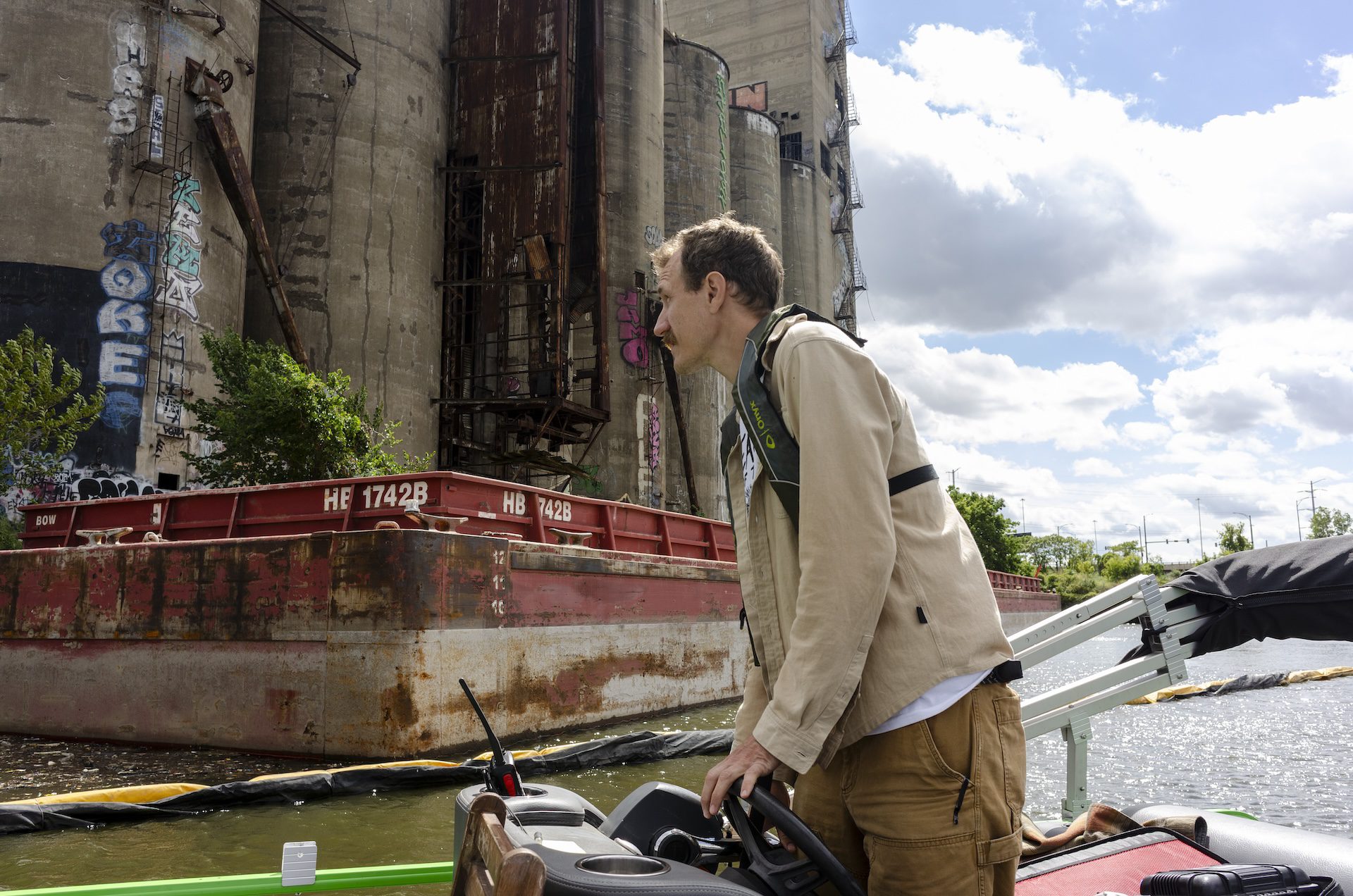
Looking ahead
As surveillance continues, so does the uncertainty over the site’s future use.
Romo of N4EJ says they are preparing to push back against a redevelopment that could bring in more pollution to McKinley Park.
“If [Tadin] has an intention to bring another source of air pollution, we’re going to challenge that,” Romo said.
At the same time, residents on the Southwest Side are also bracing for the demolition of the Fisk Generating Station in Pilsen, an abandoned coal plant about two miles away. Citing similar concerns of environmentally hazardous dust polluting the air and waterways in the process, local advocates like Chatha from PERRO are urging the city to deny demolition permits for the retired plant.
Demolition oversight and future redevelopment of these two sites in an already environmentally overburdened area could determine how much added pollution these neighborhoods receive.
Chatha says that whatever replaces these towers will shape their neighborhood for decades to come.
Aydali Campa is a Report for America corps member and covers environmental justice and immigrant communities for Borderless Magazine. Send her an email at [email protected].
